Table of Contents ![]()
Types of Money: Commodity, Fiat & Commercial
What is Money
Money is a medium of exchange that allows people to trade without needing what the other wants. In other words, money acts as an intermediary. Instead of making a direct trade, an indirect trade can be made instead.
For instance, Mr B wants to buy a chicken from Mr A. However, Mr A wants a fish in exchange for their chicken. Mr B does not have the fish that Mr A wants, so an exchange cannot be made. Instead, Mr B gives Mr A $10 for the chicken. Mr A can then use that money to buy the fish from somewhere else. That way, the trade is able to take place.
There are many types of money, and they can come in many forms. So long as people trust and accept it – it can be used as a medium of exchange.
For example, gold was historically used as a form of monies. Farmers would go to the market and sell their cows in exchange for a certain amount of gold. The farmer could then exchange his gold for a loaf of bread from the baker. The farmer wouldn’t exchange his cow for gold if he knew the baker wouldn’t accept it in exchange for some bread.
Types of Money
On its own, money is essentially worthless – except for commodity money. It is the trust that people place in it that gives it value. For certain types of money, such as commodities (gold/silver), there is an element of stored value. By contrast, other types such as fiat money are only backed by the government and people’s faith in it.
The third type of money is not what we would traditionally call ‘money’, but rather debt. This is known as commercial bank money and is backed by governments and central banks. Its trust first comes from depositors who store their money, then, from the commercial banks that lend money. Both depositors and commercial banks trust that they will get their money back and that it will still have value when they do.
Let us now look into these three types of money below:
1. Commodity Money

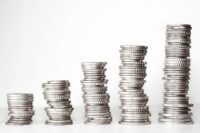
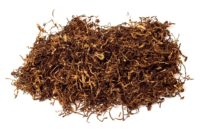
Origins of Commodity Money
Commodity money has been around for millennia. Its origins are almost impossible to determine, but records suggest that commodities such as gold became a common form of money during the period 700-500BC.
The origins of commodity money link back to the Lydian merchants, who produced a gold coin mixed with silver – otherwise known as ‘electrum’. This became a standardized unit of value to help traders convert money and trade between countries. The electrum coin later achieved royal ascent in 550 B.C., as it went into full circulation under the order of King Croesus of Lydia.
Types of Commodity Money
In the preceding centuries, salt, gold, silver, tobacco, and even seashells, were all used as forms of money. Gold became the most favoured because it met three functions of money: a medium of exchange, store of value, and limited availability.
Salt, tobacco, and seashells were commonly used. However, they often went through periods of rapid and excess supply – which meant inflation would result. By contrast, gold was rare enough to prevent a huge influx in the supply of money that would cause inflation. And even though the gold rush of the 19th Century increased the gold supply significantly, it was nowhere near as destructive as the increases in the supply of other commodities, such as salt or tobacco.
What is Commodity Money
Unlike other forms of money, commodity money has a store of value. Even if nations no longer use a commodity as a form of money, it still has value. It is physical. We can see it and touch it. However, other forms of money cannot be seen or touched and are solely built upon the trust of its value.
A commodity is a real thing, so to speak. The underlying value of commodity money is what builds people’s trust in it. Gold, silver, and tobacco all have uses outside of its use as a medium of exchange. So even if it was to be rejected by one store, it will have significant value elsewhere. This contrasts sharply with fiat money, where its value is built upon by the nation’s trust in government.
In economic terms, commodity money has ‘intrinsic value’. In other words, it has a value other than its use as money. For instance, gold can be used as a medium of exchange, but it can also be used for jewellery, gilding, or, an insulator. So, quite simply, it has other uses.
Why Commodity Money
Commodity money was used because it provided a good store of value. It was something everyone could trust.
As we trust the dollar backed by the government today, people trusted a gold coin stamped with the Royal seal. Even items such as salt or tobacco were trusted, because people knew they were well demanded commodities.
As items such as salt and tobacco were in demand, they could be traded easily. Even if one party did not want a commodity, they knew they would be able to trade it with a third party.
It was because of commodities’ intrinsic value that trust was fostered. And it was with that trust which allowed it to become widely accepted throughout the world.
2. Fiat Money
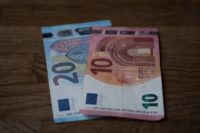
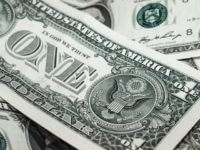
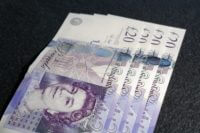
Origins of Fiat Money
The origins of fiat money come from the Chinese Tang dynasty in the 11th Century. By the 12th Century, fiat money had become widely used throughout the country. It came under various names such as; jiaozi, huizi, and guanzi.
During the 13th century, Marco Polo described the fiat money of the Yuan Dynasty in his book The Travels of Marco Polo:
All these pieces of paper are issued with as much solemnity and authority as if they were of pure gold or silver; and on every piece, a variety of officials, whose duty it is, have to write their names, and to put their seals.
What is Fiat Money
Fiat money only has value by people’s trust in it. This trust is built by governments declaring it as a legal tender – allowing all people and businesses to accept it as a means of payment. Trust is then further secured as governments outlaw all other forms of money.
“Whilst Commodity money has intrinsic value, fiat money does not.”
Unlike Commodity money, fiat money has no intrinsic value. It is backed by the government and created by central banks. And it is because there is no limitation on supply that inflation is more likely under fiat money. Governments and central banks can simply create more of it when needed. Although, with that said, this was also a common occurrence under commodity money, as rulers would simply reduce the level of gold content in the coins it issues.
Whilst there is only so much gold or silver in the world, there is no limit on how much fiat money there is. Two notable examples include the hyperinflation in Venezuela and Zimbabwe. The two respective governments had no checks in place as they continued to create new fiat money.
Types of Fiat Money
Fiat money is widely used today through the modern and even the developing worlds. These usually cover bank notes and coins. Such examples include the Euro, the US dollar and the Great British Pound.
However, fiat money does not cover banknotes that people can exchange for gold or silver. During the period of the golden standard, there were banknotes – but we cannot define these as fiat money. That is because it is essentially backed by a commodity that has an intrinsic value. As people could trade the banknotes for gold, they had some value.
History of Fiat Moneys Rise
The gold standard and other commodity monies were very restrictive. A country is bound by its stock of gold. If a country has low levels of gold reserves, it would be unable to meet its financial commitments. This can cause people to lose trust in the government’s ability to meet its promises.
Back during the gold standard, the US cut official ties in 1933 after the Great Depression. It banned the sale and exchange of gold throughout the country, although it did let foreign countries exchange at a rate of $35 to an ounce of gold. This worked well as the US had high levels of gold reserves and the international exchange rates were kept in line through the Bretton Woods agreement.
The issue lied in the fact that the US adopted fiat money at home, but guaranteed a commodity-backed currency abroad. In other words, the US linked other currencies such as the British pound to the US dollar, which could, in turn, be exchanged for gold. This didn’t work as the Federal Reserve was increasing the supply of the dollar in the US. In turn, greater numbers of US dollars were flowing to other countries as the US traded with other nations.
The money supply of US dollars was increasing, but the exchange rate to an ounce of gold remained at $35. As time wore on, the US was printing more dollars than it could back internationally with its gold reserves. By 1966, the US would have been unable to meet its obligations. Foreign nations had over $14 billion in US dollars, whilst the US treasury only had $13.2 billion in gold reserves.
“Over the years, it became clear that the supply of gold was insufficient to meet the economic output of rapidly growing economies.”
Over the years, it became clear that the supply of gold was insufficient to meet the economic output of rapidly growing economies. There was also a tendency for Central Banks to try and maximising employment, which meant huge amounts of money were injected in order to achieve this aim. This increased the number of dollars in circulation, but not the amount of gold needed to represent the newfound money.
Why Fiat Money
Fiat money is potentially a more stable form of money than commodities. This is because there is a steady supply provided by the central bank or government – whoever is in control.
By contrast, a sudden surge in the quantity of gold, silver, or other commodity would increase the money supply dramatically. Historically, this has caused sharp decreases in its value – meaning inflation has resulted.
Fiat money gives central banks and governments much more control over the money supply. It can control shocks better, and it is more adaptable to stimulating the economy. The main issue, however, is the inability to limit how much governments can print.
As governments are in the business of winning votes, it is very easy for politicians to offer free stuff. Governments then pay for that free stuff through newly printed money. However, this causes the type of hyperinflation we have seen in Venezuela, Zimbabwe, or the Weimar Republic in Germany.
The way around this was to have independent Central Banks that are self-funded and have a set mandate. That mandate today is generally to hold inflation down to around 2 percent, whilst also ensuring economic stability. To varying extents, Central Banks have largely achieved their aims, but only thanks to the ability to create fiat money from thin air.
3. Commercial Bank Money

Commercial Bank Money is essentially debt that is created through the fractional reserve system. For every $100 received in deposits, banks may only keep $10 behind to satisfy depositors’ short-term withdrawals, whilst lending out the other $90.
This creates what is commonly referred to as the ‘money multiplier’ effect. It is calculated by dividing 1 by r (1/r), where r equals the reserve ratio. In this case, the ratio would be 10%, which once divided by 1 equals 10. This multiplier effectively states how much money the original deposit creates; which for this example is $100. The multiplier, therefore, shows that the original $100 multiplies to create $1,000.
To demonstrate how this works, let us look at the existent amount of notes and coins in circulation. In total, the US has just under $1.5 trillion in circulation. How can that work when the GDP of the US is just over $19 trillion? At the same time, the M3 money supply – one of the broadest measures – is $15 trillion. That means $15 trillion is in circulation, despite only $1.5 trillion being the actual currency. The $13.5 trillion that is unaccounted for is commercial bank money – or debt.
We can define this as commercial bank money. Only $1.5 trillion is fiat currency. Banks create the rest as debt, or ‘IOUs’. If everyone claimed their debts all at the same time, there would be massive levels of deflation. This is because commercial bank money would cease to exist.
Origins of Commercial Bank Money
Its origins date back to the medieval period. The Bardi, Peruzzi, and Acciaiuoli companies of Florence were among the first banks to use fractional reserve banking. Dating back to the beginning of the 12th century, they became among the leading lenders in Europe. This system is essentially what banks use today, with them lending out a proportion of what they receive from deposits.
What is Commercial Bank Money
Commercial Bank money is debt that has been created by banks with customers fiat money. It is essentially an ‘IOU’ created by the bank, with the ledger marking some figures in the customers account.
When Customer A goes to Bank A, they put $100 in their checking account. That bank keeps $10 aside. This is what is called the ‘reserve ratio’. It then lends $90 out to another customer, Customer B. They then buy something from Customer C for $90. Customer C then puts the $90 into Bank A.
So Bank A has the original $100 that it started with. However, there is a catch. Bank A owes Customer A $100, but also Customer C $90. If both customers come to collect their money, Bank A will be unable to meet its obligations. It is therefore reliant on Customer B to pay back the $90 they borrowed.
Bank A has total assets of $190. That includes the $100 in physical money deposited by Customer A and subsequently Customer C. Also, the debt provided to Customer B is classified as an asset. At the same time, they have to pay Customer A their $100 and Customer C their $90.
So in total, $190 is going around in circulation, despite there only being $100 in fiat currency. The extra $90 has been created as debt by the bank and represents what we call Commercial Bank Money.
About Paul
Paul Boyce is an economics editor with over 10 years experience in the industry. Currently working as a consultant within the financial services sector, Paul is the CEO and chief editor of BoyceWire. He has written publications for FEE, the Mises Institute, and many others.

Further Reading
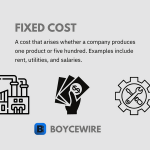 Fixed Cost: Definition, Examples & Effects - A fixed cost is a cost that a business must pay whether it produces one good or a million. Regardless…
Fixed Cost: Definition, Examples & Effects - A fixed cost is a cost that a business must pay whether it produces one good or a million. Regardless…  Free Market: Definition, Pros, Cons & Examples - A free market is where the people in an economy are free to engage in economic activities and transactions without…
Free Market: Definition, Pros, Cons & Examples - A free market is where the people in an economy are free to engage in economic activities and transactions without… 